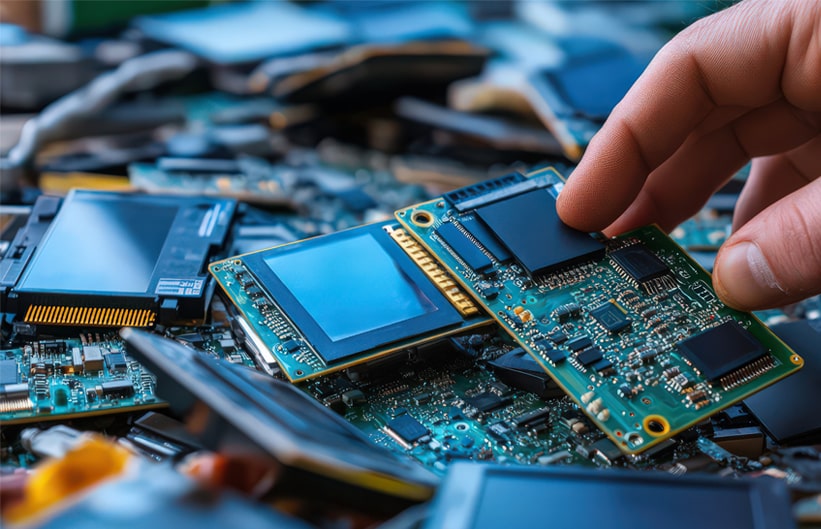Executive Summary
This whitepaper underscores the critical role of medical device design and its profound implications for regulatory adherence and compliance. It explores how meticulous design processes ensure regulatory alignment and enhance product safety and efficacy, ultimately fostering stakeholder trust and advancing patient care standards.
Medical devices (MDs) play a crucial role in modern healthcare, yet amidst industry expansion and innovation, there's often a strong emphasis on performance and swift approvals, sometimes overshadowing safety and vigilance reporting. However, ensuring patient and user safety remains paramount. Manufacturers must ensure MDs perform reliably throughout their lifecycle, requiring continuous scrutiny of design aspects. Key considerations include user needs, context of use, and the risk-benefit balance.
Transitioning an MD from concept to real-world healthcare environments is akin to integrating human and technological systems. This integration is vital as the industry introduces advanced technologies while addressing regulatory complexities and maintaining patient safety amidst evolving medical practices.
Regulatory frameworks strive to harmonize risk identification and communication, facilitating timely mitigation and enhancing patient safety.
Studying MD usability and emphasizing design's impact on safety is crucial. Human Factors Engineering (HFE) principles, borrowed from domains like aviation, are increasingly integrated into MD design to optimize usability and mitigate risks. This paper aims to clarify the crucial intersection of MD design, safety, and regulatory compliance, advocating for the adoption of HFE to navigate emerging technologies and consistently enhance healthcare outcomes responsibly.
Introduction
In the realm of emerging medical technologies and modern medical devices (MDs), there is a constant push for advancements that enhance both survival rates and quality of life. However, these innovative technologies are often marred by issues such as data cover-ups and a lack of stringent controls before and after authorization. HFE can play a crucial role in addressing these issues by ensuring that the design process is transparent, user-centered, and includes rigorous testing to mitigate residual risks effectively.
The Basics of Human Factors Engineering (HFE)
So, what exactly is HFE? At its core, it’s the practice of making things user-friendly. In medical device designing, this means understanding how humans interact with technology and designing devices that are intuitive, easy to use, and aligned with our natural abilities and limitations.
Why is HFE so crucial?
It’s simple: when products are designed with the user in mind, they’re safer and easier to use. Medical devices designed without proper consideration of human factors can lead to mistakes. Imagine a poorly designed interface on a defibrillator – it could cause precious seconds in an emergency.
How Human Factors Engineering is Evolving?
As technology advances, so does the field of HFE. We’re now seeing more focus on inclusive design, which aims to create accessible products for people of all abilities. This means considering a wider range of human diversity – from different physical abilities to cognitive differences.
Virtual and augmented reality are also opening new doors for HFE. Designing immersive experiences that are comfortable and intuitive is a whole new challenge, but it’s one that HFE is well-equipped to tackle.
The Importance of Medical Device Design
Ensuring Compliance and Safety
The design and development phases of MDs are pivotal in ensuring compliance with regulatory standards and safety requirements. Well-designed devices reduce the likelihood of errors, enhance usability, and ultimately contribute to patient safety. MD design not only influences device effectiveness but also minimizes the potential for use-related errors, thereby preventing adverse events. A comprehensive approach to MD design is essential to identify and rectify potential design flaws that could endanger patients or compromise device functionality.
Statistical Analysis of Device Recalls
In their analysis of the Medical Device Recall Report spanning FY 2010 to FY 2012, the FDA meticulously categorized the reasons behind recalls. They identified that more than 30% of recalls were attributed to failures in design, marking it as the predominant cause of these incidents. This statistic highlights the critical need for thorough design control processes and the integration of HFE principles to mitigate design-related risks. To check the list of FDA medical device recalls for 2024, click here.
The FDA has developed this guidance document to help the industry adhere to proper human factors and usability engineering processes. It aims to enhance the safety and effectiveness of new medical devices for their intended users, purposes, and environments of use.
The Role of Human Factors Engineering in MD Design
The incorporation of HFE principles in MD design and development is crucial for enhancing user safety and device usability. HFE emphasizes understanding user behavior, limitations, and system interactions to design devices that are intuitive and user-friendly. By adopting HFE in MD design, manufacturers can identify any potential issues early in the development process. This helps mitigate risks and improve overall user experience, thereby instilling confidence in the safety of the devices.
- User-Centered Design: HFE emphasizes a user-centered design approach, prioritizing the requirements and abilities of the target user population. This includes comprehensive usability testing, where prototypes are rigorously tested in real-world scenarios to identify potential issues early in the design process, demonstrating the thoroughness and care in the design process.
- Risk Mitigation: By identifying and addressing potential use errors through rigorous human factors validation, designers can significantly reduce the likelihood of design-related malfunctions. This is crucial for devices that are often used in high-stress, time-sensitive environments.
- Regulatory Compliance: Regulatory bodies like the FDA mandate the inclusion of HFE in the inclusion of HFE in the medical device design process. Compliance with these guidelines ensures safety and facilitates the approval process, bringing safe and effective devices to market more swiftly.
Ignoring HFE Can Lead to Product Recalls
Despite technological advancements and design methodologies, product recalls due to design malfunctions and poor development are not uncommon. The absence or inadequate integration of HFE can lead to several issues:
1. User Errors: Poorly designed interfaces and non-intuitive controls can lead to user errors, some of which can lead to severe consequences. For example, a complex infusion pump interface might result in incorrect dosage administration, endangering patient lives.
2. Product Complexity: Devices that are overly complex or do not account for the user’s environment and conditions can be prone to misuse. This is particularly true for home-use medical devices, where the user may not have a medical background.
3. Lack of Proper Testing: Insufficient usability testing can result in overlooking critical design flaws that might not become apparent until the device is in widespread use. These latent issues often lead to recalls once they manifest in the field.
HFE methods offer an additional approach for detecting design flaws in devices such as infusion pumps.
1. Infusion Pumps: Numerous recalls of infusion pumps have been attributed to design flaws that led to incorrect dosages being administered. These recalls often cited inadequate consideration of user interaction with the device, highlighting the need for robust HFE practices.
2. Implantable Devices: Instances of recalls in implantable devices, such as pacemakers, have occurred due to user interface issues that complicated the programming and monitoring processes. These problems could have been mitigated with better HFE integration during the design phase.
3. Diagnostic Equipment: Misinterpreting diagnostic data due to poorly designed displays and controls has also led to recalls. Ensuring that diagnostic equipment provides clear, unambiguous information is a key aspect of HFE.
Moving Forward: Enhancing HFE in Medical Device Design
To reduce the incidence of product recalls and enhance patient safety, medical device manufacturers must:
- Invest in Comprehensive HFE Programs: By embedding HFE principles throughout the design and development lifecycle, companies can create safer and more effective devices.
- Conduct Rigorous Usability Testing: Involving actual end-users in the testing process helps identify and rectify potential issues before the device reaches the market.
- Collaborate with Regulatory Bodies: Engaging with regulatory agencies early in the design process ensures compliance with HFE guidelines and smoothens the approval process. Consult iLenSys for discussions on your product life cycle and obsolescence management.
- Continuous Improvement: Post-market surveillance and feedback loops are essential for continuously improving device design based on real-world usage data.
Design-Related Regulations
Regulatory standards such as the International Organization for Standardization (ISO) 13485 and FDA guidelines govern the design control process for medical devices, emphasizing Risk Management as an integral component of product development. Ensuring compliance with these standards from the initial stages of design contributes to the production of safe and effective devices. Recent regulations, like the Medical Devices Regulation (MDR) 2017/745, highlight the importance of integrating Risk Management into MD development, emphasizing the need for a comprehensive safety-driven approach.
Incorporating HFE in the design process ensures compliance with regulatory standards and leads to enhanced market acceptance and trust in the device. Devices that pass stringent HFE testing are more likely to gain regulatory approval and user acceptance, leading to better market performance.
Interplay between HFE and Obsolescence Management
HFE plays a crucial role in managing obsolescence by ensuring that transitions between old and new components or systems are user-friendly and maintain operational continuity. Here's how they interact:
User-Centered Upgrades: HFE ensures that replacement components are designed with the user in mind, making transitions smoother and reducing the learning curve.
Ergonomic Continuity: By focusing on ergonomics, HFE ensures that new components fit seamlessly into existing systems, minimizing physical strain and maximizing efficiency.
Effective Training: HFE emphasizes the development of comprehensive training programs for new components, ensuring users can adapt quickly and safely.
Mitigating Human Error: HFE contributes to risk assessments by identifying potential human errors during transitions and designing controls to mitigate these risks.
Feedback and Improvement: HFE ensures that there are effective feedback mechanisms in place, allowing users to report issues and contribute to continuous improvement.
Change Management: HFE supports change management by considering human factors in transitions, helping to manage resistance, and ensuring successful implementation.
In summary, integrating HFE into obsolescence management ensures that technological updates and replacements are not only technically sound but also user-friendly, safe, and efficient. This holistic approach enhances overall system performance and user satisfaction. Consult iLenSys to manage obsolescence effectively throughout the products’ lifecycle.
Future Directions and Innovations in HFE
Technological Advancements: Latest technologies including artificial intelligence (AI) and machine learning (ML) are being integrated into medical device design, guided by HFE principles to enhance user interaction and device performance. For instance, AI-powered diagnostic tools designed with HFE considerations improve accuracy and ease of use, benefiting clinicians and patients.
Telemedicine and Remote Care: The rise of telemedicine necessitates the design of medical devices that are easy to use in home settings. HFE plays a critical role in ensuring these devices are user-friendly and effective. Examples include remote monitoring devices for chronic disease management designed with HFE principles to improve patient compliance and health outcomes.
Virtual Reality (VR) and Augmented Reality (AR): When designed with HFE, these technologies can enhance medical training and patient care by offering immersive and interactive experiences. For instance, VR-based surgical simulators designed with HFE principles provide realistic and effective training for surgeons, reducing the risk of errors in actual procedures.
Conclusion
Integrating Human Factors Engineering into designing and developing medical devices is essential for enhancing safety, efficiency, and patient outcomes. By prioritizing user needs and interactions, HFE ensures that medical devices are compliant with regulatory standards and effective and user-friendly. The ongoing integration of HFE principles in medical device design promises to advance healthcare delivery, improve patient safety, and drive innovation in the medical device industry.
Consult iLenSys to book a Demo on our Obsolescence Management Application and receive a free Risk Assessment and BoM Scrub.
References and Further Reading:
Teodora Miclăuş, Vasiliki Valla, Angeliki Koukoura, Anne Ahlmann Nielsen, Benedicte Dahlerup, Georgios-Ioannis Tsianos, Efstathios Vassiliadis. The Influence of Design on Medical Device Safety. Published online: 9 December 2019
Brand D. Just a piece of equipment? The importance of medical device education. J Perioper Pract. 2012;22(12):380–382.
Billaux M, Borget I, Prognon P, Pineau J, Martelli N. Innovative medical devices and hospital decision-making: a study comparing the views of hospital pharmacists and physicians. Aust Health Rev. 2016;40(3):257–261.
https://www.sciencedirect.com/science/article/abs/pii/S0003687013001208
https://www.ncbi.nlm.nih.gov/pmc/articles/PMC8641423/
https://psnet.ahrq.gov/web-mm/wrong-channel
ISO. ISO 13485:2016 Medical devices -- Quality management systems -- Requirements for regulatory purposes. [Accessed 2021 May 19]. Available from: <https://www.iso.org/standard/59752.html>.
FDA. Design control guidance for medical device manufacturers. <https://www.fda.gov/regulatory-information/search-fda-guidance-documents/design-control-guidance-medical-device-manufacturers>.
Please Enter your Business Email to download the WhitePapers
ilensys needs the contact information you provide to us to contact you about our products and services. You may unsubscribe from these communications at any time. For information on how to unsubscribe, as well as our privacy practices and commitment to protecting your privacy, please review our Privacy Policy.
Talk to ours Obsolescence Management Experts.
By submitting this form, I agree to receive emails about iLenSys's products and services as per the Terms of Use. I can unsubscribe at any time via the 'unsubscribe' link in iLenSys emails or by emailing contact@ilensys.com. I also agree to the Privacy Policy.
Sign up for the latest Blogs, Case studies, Whitepapers, Webinars and Videos.
- Blogs
- Case Studies
- News and Updates
- Videos
- Webinars
- White Papers
-
- Product Environmental Compliance
- Obsolescence Management
- Regulatory & Product Safety
-
-
-
-
-
-
- New Product Development
- Mechanical Design
- FEA Validation
- Benchmarking and Value Engineering
- 3D Scanning and Reverse Engineering
- 3D Printing
-
- Embedded Systems
-
- Industrial Automation
-
- Quality Assurance and Regulatory Affairs
-
- Extended Reality
- 3D Animation & Video Production
- WebGL Development
- Graphics and UI/UX Reality
-
- Technical Documentation
-
- Early Engineering Talent (EET)
-
-
-
- Lab Equipment
- Medical Devices and Equipment
-
- Scientific Instruments
-
- Life Sciences
-
- Static and Mobile Equipment
-
- Material Handling Equipment
-




